Technological structure and configuration of the use of technology in European sports organizations
Estructura tecnológica y configuración del uso de la tecnología en organizaciones deportivas europeas
Ana María Magaz, Leonor Gallardo, María Marin-Farrona, Javier Sánchez-Sánchez, Antonio Lorenzo, Jorge López-Fernández, Daniel Duclos-Bastías, Jorge García-Unanue
Technological structure and configuration of the use of technology in European sports organizations
Cultura, Ciencia y Deporte, vol. 19, no. 60, 2024, https://doi.org/10.12800/ccd.v19i60.2145
Universidad Católica San Antonio de Murcia
Department of Physical Activity and Sport Sciences, Universidad de Castilla-La Mancha, IGOID Research Group, Toledo, Spain
Department of Physical Activity and Sport Sciences, Universidad de Castilla-La Mancha, IGOID Research Group, Toledo, Spain
Department of Physical Activity and Sport Sciences, Universidad de Castilla-La Mancha, IGOID Research Group, Toledo, Spain
Antonio Lorenzo
Department of Physical Activity and Sport Sciences, Universidad de Castilla-La Mancha, IGOID Research Group, Toledo, Spain
Jorge López-Fernández  *
*
Faculty of Sport Sciences, Universidad Europea de Madrid, Madrid, Spain
Department of Physical Activity and Sport Sciences, Universidad de Castilla-La Mancha, IGOID Research Group, Toledo, Spain
IGEO Research Group, School of Physical Education, Pontificia Universidad Católica de Valparaíso, Valparaíso, Chile
Department of Physical Activity and Sport Sciences, Universidad de Castilla-La Mancha, IGOID Research Group, Toledo, Spain
Received: 30 november 2023
Accepted: 07 march 2024
Abstract: The sports industry faces the challenge of digital transformation. However, the degree of digitalization and technological transformation of this industry is unknown. The aim of this study was to evaluate the perception of the use of digital technology, digital competences in European sports organizations and to understand their technological structure. Based on approaches from economic, organizational and management theory, a questionnaire was designed and administered to a sample of 569 managers of organizations from different sports modalities and European countries (Austria: 9.0%; Cyprus: 5.8%; Ireland and the United Kingdom: 8.8%; Italy: 9.7%; Portugal: 51.8%; Spain: 14.9%). A five-point Likert-type scale was used. The results showed that they practically do not use this technology (2.45), that 43.2% do not have technologies for data analysis and 48.85% for the evaluation of tactical technical physical performance. Furthermore, this is somewhat important (3.73), moderately complicated to use (3.05) and very expensive (2.79). Nor do they have very developed digital skills (2.95). This analysis highlights the need to implement digital organizational culture, planning investment strategies in digitalization and training in digital skills.
Keywords: Digitalization, sport, technology, organizational theory, sport management.
Resumen: La industria deportiva se enfrenta al reto de la transformación digital. Sin embargo, se desconoce cuál es el grado de digitalización y transformación tecnológica de esta industria. El objetivo de este estudio fue evaluar la percepción del uso de la tecnología digital, las competencias digitales en las organizaciones deportivas europeas y conocer su estructura tecnológica. Partiendo de planteamientos de la teoría económica, organizativa y el management, se diseñó y administró un cuestionario a una muestra 569 responsables de organizaciones de diferentes modalidades deportivas y países europeos (Austria: 9,0%; Chipre: 5,8%; Irlanda y Reino Unido: 8,8%; Italia: 9,7; Portugal: 51,8%; España: 14,9%). Se empleó una escala tipo Likert de cinco puntos. Los resultados mostraron que prácticamente no usan esta tecnología (2,45), que el 43,2% no disponen de tecnologías para el análisis de datos y el 48,85% para la evaluación del rendimiento físico técnico táctico. Además, que esta es algo importante (3,73), medianamente complicada de usar (3,05) y muy cara (2,79). Tampoco tienen muy desarrolladas las competencias digitales (2,95). Este análisis pone de manifiesto la necesidad de implantar la cultura organizativa digital, planificando estrategias de inversión en digitalización y de formación en competencias digitales.
Palabras clave: Digitalización, deporte, tecnología, teoría organizacional, gestión deportiva.
Introduction
Digitalization (the process of converting continuous data into numbers) (Digital Business Assurance (MTP), 2017; Gray & Rumpe, 2015) is the foundation of the current digital context, which is shaped by (i) the use of technologies that enable the capture, storage, and management of data (digital technologies), (ii) the interconnection of physical elements that can communicate with each other (IoT), and (iii) the machine learning that enables artificial intelligence (ComputerWorld, 2014; Digital Business Assurance (MTP), 2017; Norton, 2016). In fact, the integration of technologies such as the Internet of Things and supportive computing in constructing sports training evaluation systems marks a significant advancement in training methodology, allowing for more accurate and real-time data collection and analysis (Zhang & Zhao, 2023).
Digital innovations in recent years, the change associated with their use and application in all areas of daily life, and the digital acceleration related to COVID-19 confinement have forced digital transformation (integration of these technologies in the different areas of an organization) across all sectors (Digital Business Assurance (MTP), n.d.). Thus, in the case of football teams, this digitalization is evident in the commitment to artificial intelligence and big data tools to improve talent management and sports performance (Balzano & Bortoluzzi, 2023).
This requires, in addition, new digital skills both in the social and professional context (Cirilli & Nicolini, 2019; van Laar et al., 2019). Both aspects implement what is known as the Industrial Revolution 4.0 (Alaloul et al., 2020; Rymarczyk, 2020).
This transformation has been demanded in such a short time that a large part of society and organizations are not prepared for the new digital context, making it necessary to invest in digitalization and digital training if organizations want to survive (Mazzone, 2014; Siano et al., 2022). To this end, the European Union has launched two strategies. The first are the so-called "Next Generation" funds (European Commission, 2023) focused on transforming the economy, creating opportunities and jobs, and helping organizations adapt to the new digital context. The second, complementary to the former, is the so-called DigComp to improve the skills and competences for digital transformation (European Commission, n.d.).
The sports industry is not immune to the need for digital transformation (Volkova, 2022), affecting the four areas of activity in sports: sports management, recreation, health, and education (Díaz-Barahona, 2020; Lupton, 2020; Mataruna-Dos-Santos et al., 2020; Sánchez & Rebollo, 2010; Toto, 2022). There are numerous technological tools in the sports market. However, these can be grouped into (i) technologies for club (and organization) management, including CRM tools for management and stakeholder relations (users, clients, members, athletes, workers, etc.); (ii) technologies for physical assessment, injury prevention, and health, including those tools for controlling and evaluating athletes to improve their physical condition and prevent injuries, and for conducting physical activities in a guided and safe manner; (iii) technologies for performance measurement and tracking systems, such as sports tracking systems like GPS or video cameras; (iv) technologies for data storage, analysis, and visualization, related to data control and management (big data, report generation, etc.); (v) technologies for broadcasting and digital media, led by new OTT (“over-the-top”) platforms that offer audiovisual content on the internet; (vi) technologies for the safety and sustainability of facilities, equipment, and people: such as those preventing accidents (active and passive safety), those improving air and water quality, those contributing to the sustainability of facilities and equipment, those ensuring the cyber security of the entity and those involved in it, those preventing occupational risks, or those focused on accessibility, integration, and protection of minors and at-risk groups (Gallardo et al., 2022; Magaz et al., 2022). Although this technology facilitates and enables processes and innovations to make sports organizations more flexible, resilient, and competitive, the degree of penetration of these advances can be uneven in many cases (Bacon, 2003). Nonetheless, further research is needed to understand the degree of technological penetration among today's sports organizations and to confirm if there are inequalities between them.
Some studies analyse the impact of digital technologies in isolation or in very specific contexts: sports performance and outcomes (Ratten, 2020), sports consumption and fan experience (Glebova & Desbordes, 2021), self-management of sports performance (Rathonyi et al., 2018), refereeing (Armenteros et al., 2019), design and marketing of new sports (Schmidt, 2020). However, there are no reference works that analyse the impact of digitalization on the organizational structure and culture, in the operational sector, in sports and economic results, on the consumer, and in the industry as a whole at the same time (Pagani & Pardo, 2017; Ratten, 2020). This gap calls for studies that delve into the influence of this technology from a holistic perspective (Ratten, 2020), being one of the first conducted in the field of digital technologies by Del Águila et al. (2003) and more recently by Ratten (2020). A complete and deep understanding of its situation in relation to technological immersion will allow sports organizations to identify and evaluate opportunities, risks, costs, make decisions, and focus corporate and innovation strategy to adapt to the functioning of the industry (Chan, 2000; GSIC by Microsoft, 2019).
Theoretical frameworks
The study of the impact of digital technologies can be approached from the perspective of Management and under the paradigms of Industrial Economy Theory, Economic and Organizational Theory, or the Theory of Resources and Capabilities. Del Águila et al. (2003) made an initial approach to the subject, classifying these impacts from an exploratory, structural, and strategic viewpoint.
From the exploratory perspective (Del Águila et al., 2003), and according to the model of technology evolution in organizations (Gibson & Nolan, 1974), technologies in sports organizations can be found in one of these phases: (i) initiation (systems to improve and automate the daily management processes of the entity and save costs and time, simplify and automate administrative processes, although without trained professionals and with "fear" of their use), (ii) contagion (digital technologies are applied to different departments, although without a digitalization strategy, with employees somewhat more involved and trained in digital competencies), (iii) control (there is a concern for having the costs of digital immersion under control in the management), (iv) integration (different technologies are already integrated into different areas), (v) information management (the use of these has a strategic dimension in the organization due to its effect on results), or (vi) maturity (the use of these is part of the strategic systems but also, innovation and creativity in their use, integration, and exploitation of their functionalities become very important). Knowing in which phase of evolution this digital technology is in a sports organization helps to make strategic decisions, given that the inclusion of these improves the management and efficiency of a sports organization, modifies and regenerates the sport and its life cycle, creates new business models in sports (typology and modality of sport, e-sports), the way it is designed, produced, marketed, and consumed (Jenny et al., 2018).
From the strategic perspective and the theoretical framework of Industrial Economics (Ferguson, 2016; Porter, 1980; Porter & Millar, 1985; Tirole, 1990), possessing and using digital tools (technological advantage) impacts at a strategic and organizational level (specifically in customer satisfaction, in the sports and economic outcomes of sports organizations, and in the creation of value), and at a sectoral level (in gaining competitive advantages and differentiation). Thus, the application of these digital tools affects the entire sports industry and the competitive forces that describe it.
From the perspective of the Resource and Capability Theory (Barney, 1991; Byrd & Douglas, 2001; Peteraf, 1993; Ventura, 1996), digital technologies create advantage and differentiation when they are integrated into the organizational culture and with the other resources of the organization, and there is a commitment from the management and its intangible strategic resources (people). Therefore, the technological disruption requires that these individuals acquire, develop, and master a set of digital competencies to make the organization more competitive.
These theoretical perspectives justify the importance of digitalization and digital transformation in sports organizations (processes, structure, and outcomes), and their role in surviving in the sports industry. Thus, in line with the above, the objectives of this work are: a) to describe the perception of the use of various technologies in sports clubs; b) to describe the level of digital competence possessed by their members; c) to identify the direction in which clubs should focus their strategic digitalization efforts; and d) to analyze the reasons for the degree of penetration (use and importance) of technology in these types of organizational structures.
Materials and Methods
Design
This is an exploratory, descriptive-cross-sectional study in which a questionnaire created ad hoc for the European Project Digi-Sporting (2019-1-ES01-KA203-065505) was applied.
Participants
Clubs and organizations affiliated with national and territorial sports federations from the five participating countries were contacted by their respective federations to complete the questionnaire. In addition, to increase the reach, the link to the questionnaire was shared on the social networks of the European Project Digi-Sporting and the organizations participating in this Project. In total, 569 workers from sports clubs in different European countries and various sports disciplines voluntarily responded to the questionnaire (Table 1). The criteria for responding to the survey were having a contractual relationship with a sports club and holding a position of responsibility within it.
Countries, Positions of the Respondents, and Sports Modalities in the Sample
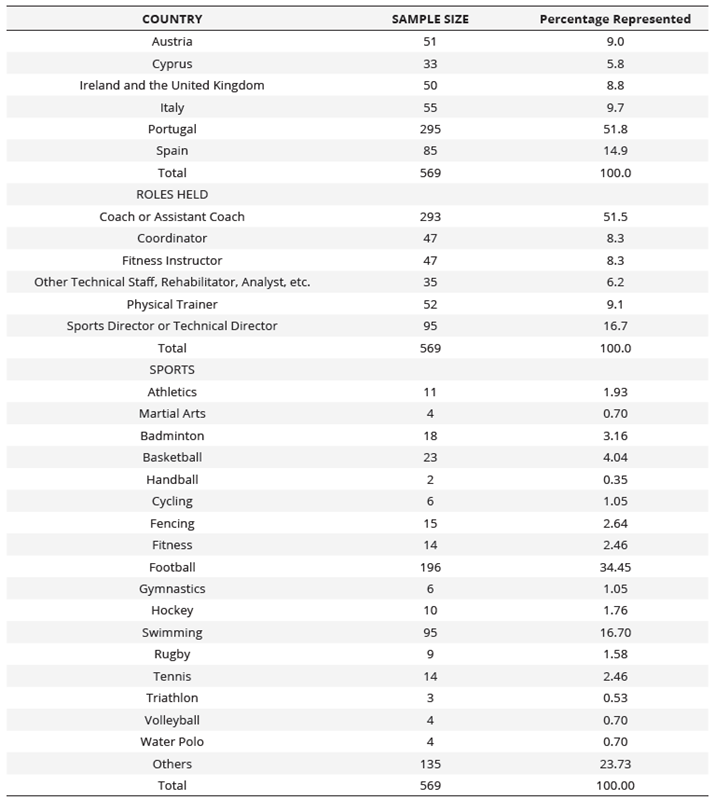
Instruments
In this research, the questionnaire created for the European Project Digi-Sporting (2019-1-ES01-KA203-065505) was used. The first two versions were designed considering the existing literature in this field and the technologies described in the European project, as well as the conclusions derived from meetings among the project partners. After this, the content of the questionnaire was validated through a focus group comprised of 12 experts at the European level. This discussion group consisted of eight PhDs with more than 10 years of experience in Sport Science research, a manager of an elite-level European club, an expert in business development in the sports sector, an expert in communication in the sports sector, and an expert in sports services.
The draft analysed by the expert group was divided into content blocks for each type of question. This draft was reviewed and modified according to the feedback received from the experts until a unanimous agreement was reached on the final blocks of the questionnaire, the items of each block, and the way to collect the response in each case. The final version of the questionnaire was divided into four blocks (Table 2) and was translated from English into the language of each participating country: (i) Block 1. General data of the questionnaire. It includes the participant information sheet: characteristics of the research, its objective, and informed consent. (ii) Block 2. Sociodemographic information. It consists of sociodemographic questions about the participant's position, the type of club they belong to (sports, academy, or fitness), years of experience in the entity and in the current position, and country. (iii) Block 3. Analysis of technology in sports. This block follows a structure similar to the Importance-Performance Analysis (IPA) model, although instead of using the same item to measure two different constructs (importance vs. valuation), the same item was used to measure four different constructs. Thus, for each type of technology described in Digi-Sporting, the following was asked (Gallardo et al., 2020; Gallardo et al., 2022): (1) perception of the use of technology in the participant's club; (2) perception of the importance of technology for the participant's club; (3) perception of accessibility to such technology related to the difficulty of its use; (4) accessibility of such technology related to the cost. In this block, a 5-point Likert scale response model was used ranging from 1 (no use / not important / technically inaccessible / economically inaccessible) to 5 (widely used / essential / extremely simple technically / very affordable). (iv) Block 4. Competencies in sports technology: Following the same structure as the IPA, for each of the seven types of technology identified, it was asked: (1) the degree of development of six hard competencies in the club; and (2) the perception of the importance of these six hard competencies. In this block, a 5-point Likert scale response model was used ranging from 1 (no one has these capabilities / not important) to 5 (there are many experts in the entity / essential).
Research Questionnaire
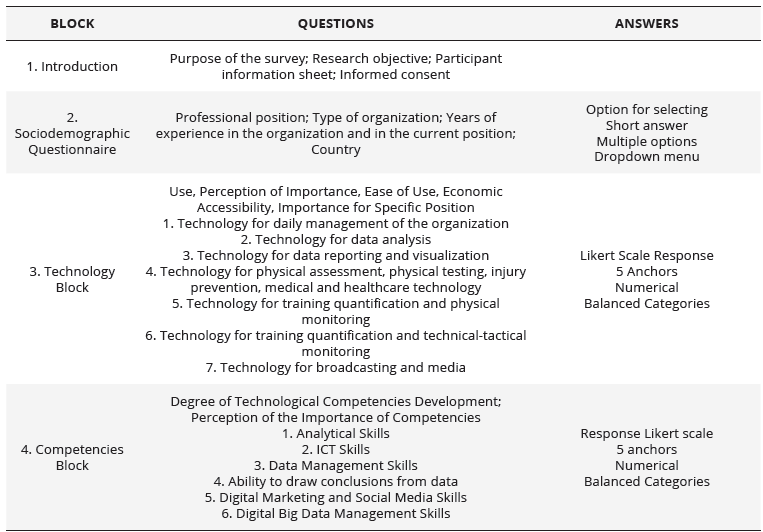
Procedure
Before accessing the questionnaire, participants had access to a downloadable participant information sheet with all the information about the project. Moreover, to proceed to the response phase, they had to complete an informed consent form. No personal information about the participants was collected, nor was any other information that could be used to identify them. Additionally, the data were processed in accordance with the General Data Protection Regulation (GDPR) of the European Union, dated May 25, 2018, and the corresponding data protection law of the participant countries.
The questionnaire was distributed online through social networks and through the contact networks of different sports federations. In the latter case, the questionnaire was sent via email. Access to it was through a Google Forms link in the language of each country in the sample. The reception of responses was open between March 26 and May 6, 2020.
Statistical Analysis
The database populated with data collected from the completed questionnaires was subjected to statistical treatment using the SPSS statistical package version 26. Firstly, a descriptive exploratory analysis (mean, standard deviation, frequencies, percentages) was carried out for each of the variables related to technology (perception of use, importance, difficulty of use, and economic accessibility to the technologies) as well as the competencies (development of the competencies and perception of their importance), performing normality tests of the sample using the Kolmogorov-Smirnov test.
Subsequently, a graphical study was conducted using IPA analysis (León-Quismondo, 2019; León-Quismondo et al., 2020; Martilla & James, 1977; Setha, 1982), opting for the analysis proposal suggested by de Ábalo et al. (2006) to avoid some criticisms of the initial model (León-Quismondo, 2019) and useful for predicting priorities (Bacon, 2003): “focus here,” “low priority,” “potential waste of resources,” or “keep up the good work.”
For the IPA analysis between the technologies and the development of competencies, it was decided to use the strategy of relating each technology with the type of competencies with which it had the most correlation according to bivariate correlation analysis. The bivariate correlation analysis significantly identified the association between the variables observed in the IPA analysis. For this purpose, the non-parametric Spearman's Rho correlation coefficient was used, and a critical significance level of p < 0.05 was established.
Results
Table 3 shows the descriptive results (between 1 and 5 points) for the perception of use, importance, difficulty of use, and economic accessibility of the 7 technological types analysed.
Descriptive Results of Perception of Use, Importance, Difficulty of Use and Economic Accessibility of Technology
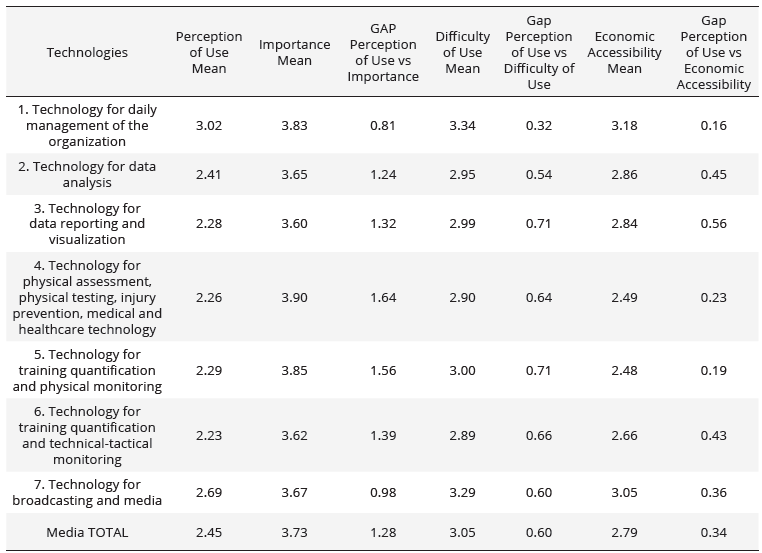
Figure 1 displays the contrast in the IPA analysis between the perception of use and importance of the different technologies. The overall results show that the levels of importance are higher than those of use (importance = 3.73; use = 2.45).
IPA Analysis of technology Use versus Technology Importance
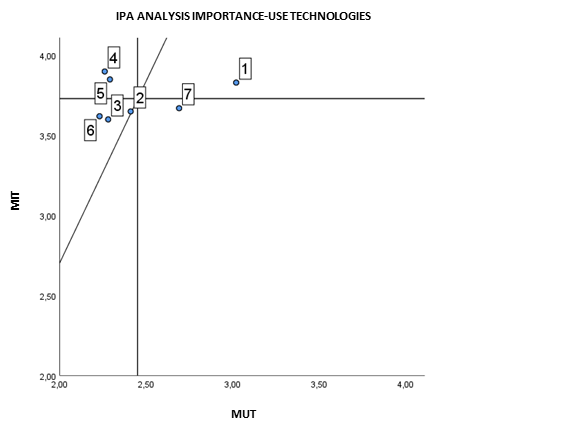
1. Technology for daily management of the entity. 2. Technology for data analysis. 3. Technology for data reporting and visualization. 4. Technology for physical assessment, physical tests, injury prevention, and medical and health technology. 5. Technology for training quantification. Physical monitoring. 6. Technology for training quantification, tactical-technical monitoring. 7. Technology for broadcasting and media.
Regarding competencies, Table 4 reflects the descriptive results (between 1 and 5 points) of the perceived level of competency development and the importance attributed to them. The results indicate that the average perceived level of competency development (2.95) is lower than the average importance attributed to these competencies (3.66).
Descriptive results of digital competencies development and importance
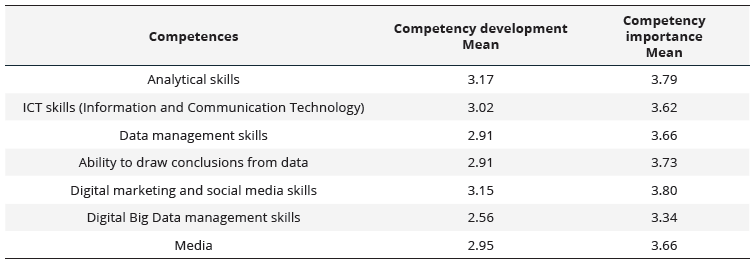
Note.Values: Competence development: 1: No one has these competencies; 2: Not developed significantly; 3: Somewhat developed; 4: Clearly developed; 5: There are true experts in the entity. Importance of competence: 1: Not important; 2: Slightly important; 3: Somewhat important; 4: Very important; 5: Essential.
Figure 2 shows the contrast in the IPA analysis between the use of different technologies (2.45 average points) and the development of certain digital competencies related to each technology (3.00 average points).
IPA Analysis of Technology Use vs Competence Development
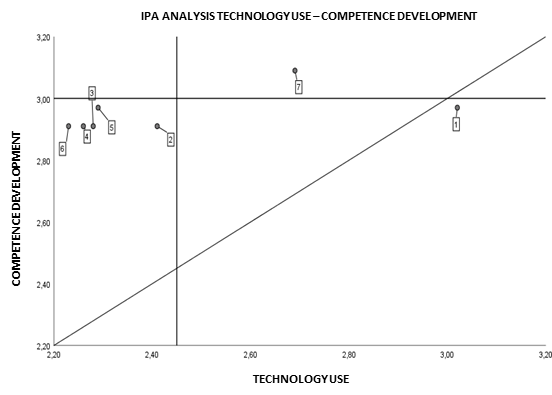
1. Technology for daily management of the entity. 2. Technology for data analysis. 3. Technology for data reporting and visualization. 4. Technology for physical assessment, physical tests, injury prevention, and medical and health technology. 5. Technology for training quantification. Physical monitoring. 6. Technology for training quantification, tactical-technical monitoring. 7. Technology for broadcasting and media. Competences: 2. ICT skills; 3. Data management skills; 4. Ability to draw conclusions from data; 5. Digital marketing and social media skills.
Table 5 shows the relationship between the perception of use of various technologies and the importance attributed to them, and between the perception of use of technologies and the development of digital competencies. The bivariate correlation analysis indicates that the perception of use of the technologies has a significant relationship with the importance given to them, being moderately strong for technologies for the daily management of the entity (T1) and for broadcasting and media (T7), as also observed in the IPA analysis.
Correlation Use-Importance Technologies-Competence Development
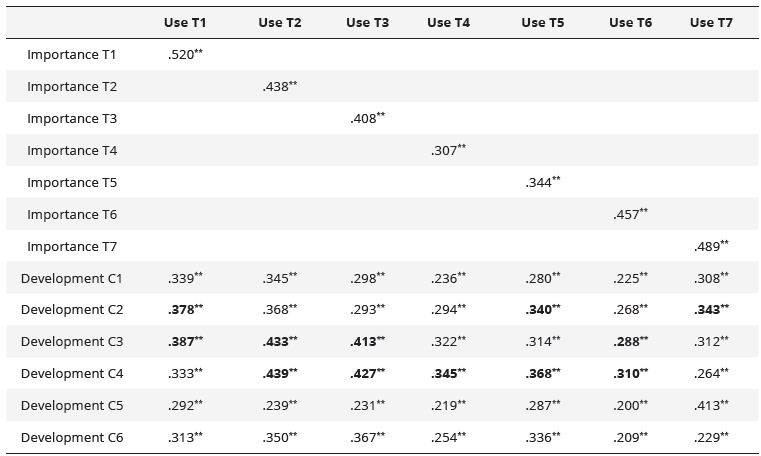
Test: Spearman's Rho. The correlation is significant at the 0.01 level (two-tailed). Technologies: 1. Technology for daily entity management. 2. Technology for data analysis. 3. Technology for data visualization and reporting. 4. Technology for physical assessment, physical testing, injury prevention, and medical and health technology. 5. Technology for training quantification. Physical monitoring. 6. Technology for training quantification. Technical-tactical monitoring. 7. Technology for broadcasting and media. Competences: 1. Analytical skills; 2. ICT skills; 3. Data management skills; 4. Ability to draw conclusions from data; 5. Digital marketing and social media skills. 6: Skills in digital Big Data management.
Table 6 shows the correlation between the development of digital competencies and the importance that organizations give to different technologies. The results reveal some significant and moderately strong relationships, such as between the competency for data management and Big Data and the technology for data analysis, or digital marketing skills and social networks and the technology for broadcasting and media.
Correlation between Digital Competence Development and Importance of Technologies
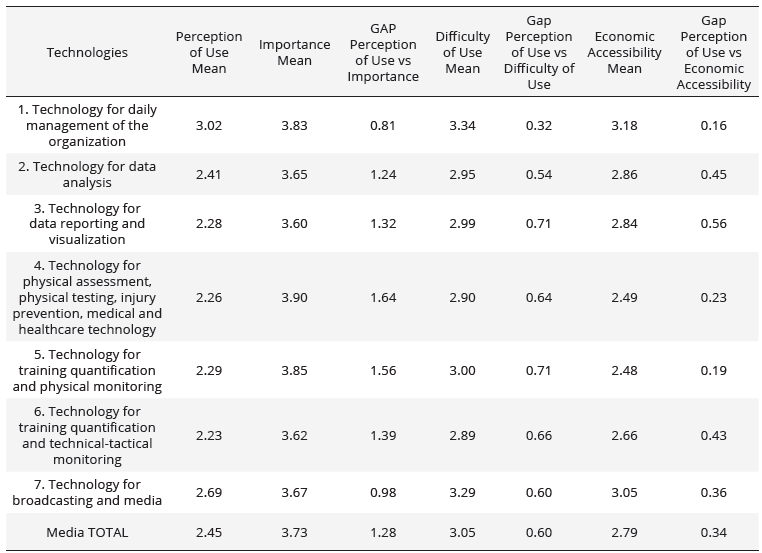
Test: Spearman's Rho. **The correlation is significant at the 0.01 level (two-tailed). Technologies: 1. Technology for daily entity management. 2. Technology for data analysis. 3. Technology for data reporting and visualization. 4. Technology for physical evaluation, physical tests, injury prevention, and medical and health technology. 5. Technology for training quantification. Physical monitoring. 6. Technology for training quantification. Technical-tactical monitoring. 7. Technology for broadcasting and media. Competences: 1. Analytical skills; 2. ICT skills; 3. Data management skills; 4. Ability to draw conclusions from data; 5. Digital marketing and social media skills; 6. Skills in digital management of Big Data.
Discussion
In recent years, a digital transformation of the various European productive sectors has been occurring (Alaloul et al., 2020; Digital Business Assurance (MTP), n.d.; Rymarczyk, 2020; Volkova, 2022), driven by the COVID-19 pandemic and implemented by European policies such as "Next Generation" (European Commission, 2023) or DigiComp (European Commission, n.d.), characterizing what has been termed the 4.0 industrial revolution (Alaloul et al., 2020; Rymarczyk, 2020). However, it is unknown how the sports industry is restructuring digitally, and there is a lack of scientific research analyzing it in a holistic manner. This study has investigated this gap by examining the technological use and digital competencies of its members.
The evidence suggests that the transformation and use of digital technologies can provide competitive advantages for sports organizations (Siano et al., 2022; Frevel et al., 2022; Syllabus Spanish, 2020) and address process limitations described by sports managers in previous studies (Solanellas et al., 2022). However, the results of this work reflect that for the European clubs analysed, these digital tools are underutilized, identifying them as only somewhat important, complicated to use, and very expensive. It also shows that digital competencies are not developed in a significant way.
Thus, the technologies for the daily management of the entity (T1) are in the integration phase as defined by Gibson and Noa (1974). They are only considered somewhat important and are used sporadically, despite their impact on improving management and daily efficiency of the organization. Therefore, clubs should focus their efforts on normalizing and integrating their use into their structure.
The technologies for data analysis and data visualization and reporting (T2 and T3) are in the contagion phase. They are considered very important or even essential, but as they are seen as complicated to use, they are hardly employed. This is despite their ability to identify key indicators, draw conclusions, make management decisions, impact cost reduction, organizational efficiency, or customer segmentation. It is necessary for organizations to focus their efforts and operational strategy on increasing the use of these technologies. In fact, their use in football clubs can contribute to an improvement in the organization's performance, both sports-wise and economically (Balzano & Bortoluzzi, 2023).
Regarding T4, this study shows that not all organizations are committing to the use and utilization of these technologies, despite their exponential growth in high-performance contexts like FIFA (FIFA, n.d.). They are, therefore, in a phase of initiation and control (Gibson & Noa, 1974). Almost half do not have these technologies, and just over half use them sporadically, even considering them important, possibly because they are considered very expensive. Having a direct impact on sports results, clubs should strive to employ them as part of their sports strategy.
Technologies T5 and T6 are also in a phase of initiation and control. They are considered somewhat important, moderately complicated to use, and for some, inaccessible. Therefore, they are not used, nor do the majority of sports organizations have them. These technologies impact efficiency and sports processes and competitive capacity, in strategic design and recruitment policies, and therefore, on sports and organizational results. It is necessary for these clubs to focus their efforts on integrating these technologies and managing them as part of their strategy and leveraging their functionalities. Indeed, as Deloitte (2023) points out, digital analytics offers sports organizations the opportunity to better understand the preferences of fans and consumers, contributing to improving business operations and also unlocking new revenue streams.
Technologies T7 are essential, especially after the COVID-19 pandemic (Frevel et al., 2022; Magaz-González et al., 2022; Siano et al., 2022; Syllabus Spanish, 2020). However, despite their influence on the commercialization of sports and value creation, the analysed entities barely use them, only considering them somewhat important and not sufficiently exploited (possible waste of resources), being in a phase of contagion. These organizations should direct their efforts towards the strategic management of these tools and leverage their functionalities creatively due to their strategic impact on the organization.
Overall, T7 and T1 (cross-cutting and support technologies) are the most developed in the entities, while the more technical and specific ones (T4-T5) are less used, and those associated with Big Data (T2-T3) are not a priority, today, for European sports organizations.
After the appropriate analysis of the discrepancies (Ábalo et al., 2006) between the scores of importance and perception of use of the technologies, the positive difference in favor of the former demands, as pointed out by Novatorov (1997) and Sethna (1982), the need to apply corrective action to improve digitalization in these organizations. The same happens when conducting the IPA analysis, which allows for determining the order of priorities in sports organizations: focus on technologies two to six, keep up the good work in T1, and possible waste of resources in T7.
In conclusion, the use of different technologies is explained by the importance given to them (as shown by the correlation analysis). This also makes sense with the interpretation of the IPA analysis. It determines that the digitalization strategy starts by making both management and intangible strategic resources aware of the potentialities of these technologies and their role in creating value and competitive advantages.
Regarding digital competencies, the results show a certain digital divide, a lack of experts in digital competencies, and even a fear of digital technologies and the change that their introduction can entail in sports organizations. Most entities have not developed them significantly and consider them only somewhat important, despite their role in decision-making, organizational synergies, and comprehensive management of the entity. Skills related to Big Data management, despite their impact on the progress of the sports industry (Bai & Bai, 2021), are the least widespread.
The IPA analysis (use-development of competencies) shows that they have sufficient digital skills for technological use, but they are wasting the capacities of their human resources to exploit the potential of these technologies. Considering the role of resources in creating competitive advantages (Barney, 1991; Byrd & Douglas, 2001; Peteraf, 1993; Ventura, 1996), these intangibles are fundamental to increasing the use of digital technologies and digital immersion in sports entities (according to the results of this study, the more digital training, the more potential use of digital technologies). Therefore, it is important to have a human resources strategy focused on digital training and the implementation of such competencies.
The European Union itself is aware of this and is promoting technological training for European citizens, through programs like DigiComp (European Commission, n.d.) or the certificate in digital skills (European Commission, n.d.). However, to address these challenges, it is crucial to integrate courses that improve digital literacy into the sports management curriculum, thereby preparing future professionals to navigate efficiently in an increasingly digitalized sports environment (Swim, et al, 2023).
To conclude, it is necessary to identify several limitations of the study. First, the sample was limited to six countries, with an uneven and non-representative distribution both in the participating countries and in the professional profile of the respondents to the surveys. All this may hinder the extrapolation of the results to other European contexts and requires care in interpreting the results. Likewise, the descriptive and cross-sectional nature of the study prevents establishing causal relationships between digitalization and its effects on sports organizations, while the fact of working with a questionnaire reduces the reliability of the results. Despite all this, this is the first study that analyzes digitalization in the sports ecosystem of different European countries, constituting a significant advance in understanding digitalization in the European sports field and helping to understand the perception and degree of application of digital technology within a sector that has been little explored to date. It is expected that this work will provide an empirical basis for future research and lay the groundwork for a deeper understanding of technological integration in sports.
To further delve into this field, it is recommended that future research opt for exploring the integration of digital technology in sports organizations through longitudinal studies. It is also relevant to conduct qualitative studies in a broader geographical diversity than in this study to deepen the understanding of the impact of technology on different sports organizations and the main barriers existing in each of the agents that make up the European sports ecosystem. Finally, including a variety of professional profiles and examining emerging technologies like artificial intelligence can provide a deeper insight into the adoption and adaptation of technology in current sports organizations across different sports contexts.
Conclusions
Digital technology is essential for sports organizations to survive in the digital age. It enables innovation and the creation of new business models in sports, impacting the structure of organizations and their outcomes.
Based on the propositions of economic theory, organizational studies, and management, the digital structure of sports industry organizations in Europe is in a big bang phase; the use of digital technologies is erratic, and its members lack sufficient competency development. In summary, there is no digital organizational culture in the European sports industry, nor a digitalization strategy that sets the roadmap for its operation in the coming years. It must focus its digitalization efforts on: (i) Implementing a digital organizational culture (both senior management and intangible resources); (ii) Properly planning digitalization investment, studying its effect on efficiency, organizational flexibility, and value creation in the organization; (iii) Providing data analysts and industry strategists who, based on data, are creative and can address threats and weaknesses highlighted by the data; (iv) Introducing continuous training strategies in digital competencies to improve the processes of these organizations; (v) Normalizing the use of digital technology; (vi) Increasing awareness of the importance of specific technologies since some technologies, such as daily management (T1) and broadcasting and media (T7), are perceived as important but underutilized; (vii) Implementing training programs to reduce the perceived difficulty of using key technologies, thus facilitating their adoption and practical application; (viii) Developing and promoting financing models, subsidies, or partnerships with technology providers to make critical digital technologies more economically accessible to sports organizations; (ix) Specifying and promoting training in digital competencies that are directly related to the effective use of technologies identified as crucial for the different areas of sports studied; and (x) Aligning the digitalization strategy with organizational needs and competency development, ensuring that digitalization strategies serve to enhance the digital competencies needed for their effective use.
Ethics Committee Statement
The application of the Helsinki Declaration or the intervention of the Ethics Committee has not been necessary. The questionnaire for the study was administered via email, through a Google Forms link in the language of each country in the sample, and in a first section, the option to accept informed consent was provided.
Conflict of Interest Statement
This publication is not subject to any conflict of interest. The entities to which the authors belong had no influence on the design of the study, the analysis of the data, or the interpretation of the results.
Funding
This research did not receive any funding. The work has been carried out without any kind of financial assistance.
Authors' Contribution
The authors of the article have contributed as detailed below (CRedit taxonomy): Conceptualization Magaz-González, A. M & López-Fernández, J.; Methodology Magaz-González, A. M. & López-Fernández, J.; Software López-Fernández, J.; Validation García-Unanue, J. & Marín-Farrona, M.; Formal Analysis Magaz-González, A. M & López-Fernández, J.; Investigation Magaz-González, A. M., García-Unanue, J.& Gallardo, L. ; Resources Gallardo, L., García-Unanue, J. & Sánchez-Sánchez, J.; Data Curation Duclos-Bastías, D., Lorenzo, A. & Sánchez-Sánchez, J.; Writing- Original Magaz-González, A. M & López-Fernández, J.; Original Draft Duclos-Bastías, D., Lorenzo, A. & Sánchez-Sánchez, J.; Writing – Review & Editing Magaz-González, A. M. & López-Fernández, J.; Visualization Sánchez-Sánchez, J.; Duclos-Bastías, D. & Lorenzo, A.; Supervision Gallardo, L. & García-Unanue, J.; Project Administration Gallardo, L. & García-Unanue, J.
All authors have read and agreed to the published version of the manuscript.
Data Availability Statement
The data that support the findings of this study are available on request from the corresponding author Jorge López-Fernández (jorge.lopez@universidadeuropea.es).
Acknowledgments
The author J. L-F. acknowledges that his contribution to this article was made possible thanks to his participation in the Fulbright program and the José Castillejo Mobility Stay for Young Doctors 2022 (CAS22/00376).
References
Ábalo, J., Varela, J., & Rial, A. (2006). El análisis de importancia-valoración aplicado a la gestión de servicios. Psicothema, 18(4), 730–737. https://reunido.uniovi.es/index.php/PST/article/view/8369/8233
Alaloul, W. S., Liew, M. S., Zawawi, N. A. W. A., & Kennedy, I. B. (2020). Industrial Revolution 4.0 in the construction industry: challenges and opportunities for stakeholders. Ain Shams Engineering Journal, 11(1), 225–230. http://dx.doi.org/10.1016/j.asej.2019.08.010
Armenteros, M., Benitez, A. J., & Betancor, M. A. (2019). The use of video technologies in referee. Routledge. https://doi.org/10.4324/9780429455551
Bacon, D. R. (2003). A comparison of approaches to importance-performance analysis. International Journal of Market Research, 45(1), 1–15. https://doi.org/10.1177/147078530304500101
Balzano, M., & Bortoluzzi, G. (2023). The digital transformation of soccer clubs and their business models. Impresa Progetto, (1), 1-20. https://doi.org/10.15167/1824-3576/IPEJM2023.1.1527
Bai, Z., & Bai, X. (2021). Sports big data: management, analysis, applications, and challenges. Complexity, 2021, 1-11. https://doi.org/10.1155/2021/6676297
Barney, J. (1991). Firm resources and sustained competitive advantage. Journal of Management, 17(1), 99–120. https://doi.org/10.1177/01492063910170010
Byrd, T., & Douglas E. (2001). An exploratory examination of the relationship between flexible IT infrastructure and competitive advantage. Information & Management, 39(1), 41–52. https://doi.org/10.1016/S0378-7206(01)00078-7
Chan, S. L. (2000). Information technology in business processes. Business Process Management Journal, 6(3), 224–237. https://doi.org/10.1108/14637150010325444
Cirilli, E., & Nicolini, P. (2019). Digital skills and profile of each generation: a review. International Journal of Developmental and Educational Psychology. Revista INFAD de Psicología, 3(1), 487. https://doi.org/10.17060/ijodaep.2019.n1.v3.1525
Comisión Europea. (n.d.). DigComp. Centro Científico de La UE. April 24, 2023. https://joint-research-centre.ec.europa.eu/digcomp_es?etrans=es
Comisión Europea. (2023). Plan de recuperación para Europa. Comisión Europea. https://commission.europa.eu/strategy-and-policy/recovery-plan-europe_es
ComputerWorld. (2014, April 10). El Universo Digital se expande acelerado por el crecimiento de los datos. Internet de Las Cosas. https://www.computerworld.es/tendencias/el-universo-digital-se-expande-acelerado-por-el-crecimiento-de-los-datos#:~:text=El%20universo%20digital%20se%20está,llamado%20Internet%20de%20las%20Cosas
Cyrus, F., Gibson, C. F., & Nolan, R. (1974). Managing the Four Stages of EDP Growth. Harvard Business Review. https://hbr.org/1974/01/managing-the-four-stages-of-edp-growth
Del Águila, A. R., Bruque, S., & Padilla, A. (2003). Las tecnologías de la información y de la comunicación en la organización de empresas. Cuestiones de investigación en un nuevo paradigma. Investigaciones Europeas de Dirección y Economía de La Empresas, 9(2), 63–80. https://dialnet.unirioja.es/servlet/articulo?codigo=713499
Díaz Barahona, J. (2020). Retos y oportunidades de la tecnología móvil en la educación física. Retos, Nuevas tendencias en Educación Física, Deportes y Recreación, 37, 767–773. https://doi.org/10.47197/retos.v37i37.68851
Digital Business Assurance (MTP). (n.d.). Transformación digital para empresas. Blog de MTP. 2023. https://www.mtp.es/transformacion-digital/
Digital Business Assurance (MTP). (2017, June 22). ¿Qué es el contexto digital? Experiencia de Usuario Para Empresas. https://www.mtp.es/blog/experiencia-de-usuario-blog/que-es-el-contexto-digital/
European Commission (n.d.). European education area. Plan de acción de educación digital – Acción 9. July 27, 2023. https://education.ec.europa.eu/es/focus-topics/digital-education/action-plan/action-9
Ferguson, G. J. (2016). Industrial Economics: Issues and Perspectives. Bloomsbury Publishing.
FIFA (n.d.). Technical. Football Technology & Innovation. July, 27, 2023. https://www.fifa.com/technical/football-technology
Frevel, N., Beiderbeck, D., & Schmidt, S. L. (2022). The impact of technology on sports – A prospective study. Technological Forecasting and Social Change, 182, 121838. https://doi.org/10.1016/j.techfore.2022.121838
Glebova, E., & Desbordes, M. (2021). Identifying the role of digital technologies in sport spectators customer experiences through qualitative approach. Athens Journal of Sports, 8(2), 141–160. https://doi.org/10.30958/ajspo
Gray, J., & Rumpe, B. (2015). Models for digitalization. Software & Systems Modeling, 14, 1319–1320. https://doi.org/10.1007/s10270-015-0494-9
GSIC by Microsoft. (2019). Digital Transformation of Sports Entities by 2025. How will it look like? The 4-ring model. http://www.sport-gsic.com
Jenny, S. E., Keiper, M. C., Taylor, B. J., Williams, D. P., Gawrysiak, J., Manning, R. D., & Tutka, P. M. (2018). eSports Venues: a new sport business opportunity. Journal of Applied Sport Management, 10(1), 34–49. https://doi.org/10.18666/JASM-2018-V10-I1-8469
León-Quismondo, J. (2019). Estudio de los Factores Críticos de Éxito en los centros fitness de gestión privada de la Comunidad de Madrid. [Tesis doctoral, Universidad Europea de Madrid]. Repositorio de Producción Científica - Universidad Europea de Madrid. http://hdl.handle.net/11268/8243
León-Quismondo, J., García-Unanue, J., & Burillo, P. (2020). Análisis de Importancia-Valoración (IPA) y Modelo Kano aplicados a centros fitness de la Comunidad de Madrid. Cultura, Ciencia y Deporte, 15(44), 223-234. https://doi.org/10.12800/ccd.v15i44.1464
Lupton, D. (2020). ‘Better understanding about what’s going on’: young Australians’ use of digital technologies for health and fitness. Sport, Education and Society, 25(1), 1–13. https://doi.org/10.1080/13573322.2018.1555661
Magaz-González, A. M.; Mendaña-Cuervo, C.; Sahelices-Pinto, C.; García-Tascón, M. (2022). Soportes TIC empleados para la práctica de actividad física durante el confinamiento. Impulso para la inmersión digital en el sector. In L. Gallardo-Guerrero, J. García-Unanue, & S. López-Carril (Eds.), Economía y Gestión del Deporte en la era de la transformación digital (pp. 521–524). IGOID-UCLM.
Martilla, J. A., & James, J. C. (1977). Importance-Performance analysis. Journal of Marketing, 41(1), 77–79. https://doi.org/10.1177/002224297704100112
Mataruna-Dos-Santos, L. J., Faccia, A., Helú, H. M., & Khan, M. S. (2020). Big data analyses and new technology applications in sport management, an overview. ICBDM 2020: Proceedings of the 2020 International Conference on Big Data in Management, 17–22. https://doi.org/10.1145/3437075.3437085
Mazzone, D. (2014). Digital transformation: the only choice for business to survive smash and conquer. Smashbox Consulting Inc.
Norton, D. (2016). Digital Context 2.0: seven lessons in business strategy, consumer behavior, and the internet of things. BookBaby.
Novatorov, E.V. (1997). An importance-performance approach to evaluating internal marketing in a recreation centre. Managing Leisure, 2(1), 1-16. https://doi.org/10.1080/136067197376248
Pagani, M., & Pardo, C. (2017). The impact of digital technology on relationships in a business network. Industrial Marketing Management, 67, 185–192. https://doi.org/10.1016/J.INDMARMAN.2017.08.009
Peteraf, M. A. (1993). The cornerstones of competitive advantage: a resource-based view. Strategic Management Journal, 14(3), 179–191. https://doi.org/10.1002/smj.4250140303
Porter, M. E.; Millar, V. E. (1985). How information gives you competitive advantage. Harvard Business Review, 64(4), 149–160. https://hbr.org/1985/07/how-information-gives-you-competitive-advantage
Rathonyi, G., É., Bácsné Bába, E., Müller, A., & Ráthonyi-Ódor. K. (2018). How digital technologies are changing sport? Applied Studies in Agribusiness and Commerce, 12(3-4), 89-96. https://doi.org/10.19041/APSTRACT/2018/3-4/10
Ratten, V. (2020). Sport technology: a commentary. The Journal of High Technology Management Research, 31(1), 100383. https://doi.org/10.1016/J.HITECH.2020.100383
Rymarczyk, J. (2020). Technologies, opportunities and challenges of the industrial revolution 4.0: theoretical considerations. Entrepreneurial Business and Economics Review, 8(1), 185–198. https://www.ceeol.com/search/article-detail?id=976200
Sánchez, A., & Rebollo, S. (2010). Current working panorama in the physical activity and sport field. European Journal of Human Movement, 6(0), 141-154. https://www.eurjhm.com/index.php/eurjhm/article/view/59
Schmidt, S. L. (editor). (2024). 21st Century Sports. How technologies will change sports in the digital age. Springer https://doi.org/10.1007/978-3-031-38981-8
Sethna, B.N. (1982). Extensions and testing of importance-performance analysis. Business Economics, 20, 28-31.
Siano, B., Jayantilal, S., Ferreira, J. J., & Carayannis, E. G. (2022). Digital transformation and strategic management: a systematic review of the literature. Journal of the Knowledge Economy, 13, 3195–3222. https://doi.org/10.1007/s13132-021-00853-3
Solanellas Donato, F., Aurélio Avila, M., Muñoz Vázquez, J., & Rosa, C. (2022). Las políticas deportivas en la provincia de Barcelona. La visión de los gestores deportivos municipales (Sport policies in the province of Barcelona. The vision of municipal sports managers). Cultura, Ciencia y Deporte, 17(51), 53-63. https://doi.org/10.12800/ccd.v17i51.1581
Swim, N., Presley, R., & Thompson, E. (2023). Digital development and technology in sport: a course to improve digital literacy in the sport management curriculum. Sport Management Education Journal, 18(1) 87-93. https://doi.org/10.1123/smej.2022-0021
Tirole, J. (1990). La teoría de la organización industrial. Ariel.
Toto, G. A. (2022). A Systematic review on digital technologies on sport science: didactic of sport. Formazione & Insegnamento, 20(1 Suppl.), 001–012. https://doi.org/10.7346/-feis-XX-01-22_01
van Laar, E., van Deursen, A. J. A. M., van Dijk, J. A. G. M., & de Haan, J. (2019). Determinants of 21st-century digital skills: a large-scale survey among working professionals. Computers in Human Behavior, 100, 93–104. https://doi.org/10.1016/J.CHB.2019.06.017
Ventura, J. (1996). Análisis dinámico de la estrategia empresarial: un ensayo interdisciplinar. Universidad de Oviedo.
Zhang, Y., & Zhao, J. (2023). Integrating the internet of things and computer-aided technology with the construction of a sports training evaluation system. Computer-Aided Design and Applications, 20, 89-98. https://doi.org/10.14733/cadaps.2023.S2.89-9
Author notes
* Correspondence: Jorge López-Fernández, jorge.lopez@universidadeuropea.es
Additional information
Short title: Technological structure in European sports organizations
How to cite this article: Magaz-González, A. M., Gallardo, L., Marín-Farrona, M., Sánchez-Sánchez, J., Lorenzo, A., López-Fernández, J., Duclos-Bastías, D., & García-Unanue, G. (2024). Technological structure and configuration of the use of technology in European sports organizations. Cultura, Ciencia y Deporte, 19(60), 2145. https://doi.org/10.12800/ccd.v19i60.2145




